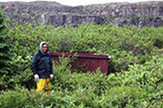Little Whale River Reveals Some Secrets During Summer 2007 Archaeological Survey
By Christian Roy, Independent Archaeologist
The Little Whale River/Richmond Gulf Archaeology Project was carried out by a team of five Cree and Inuit technicians during the months of July and August 2007. This joint project was conceived by the Cree Regional Authority and Avataq Cultural Institute within the framework of the future Parc national des Lacs-Guillaume-Delisle-et-à-L’Eau-Claire. The team consisted of Charlie Kumarluk and Willie Kumarluk from Umiujaq and Clarence Natasquan, Ricky Natasquan and Sandy Petagumscum of Kuujjuarapik-Whapmagoostui, in addition to archaeologist Christian Roy. The main goal of the investigation was to locate the various establishments operated by the Hudson’s Bay Company (HBC) at the mouth of the Little Whale River during the 18th and the 19th centuries and to evaluate the site of Richmond Fort (HaGb-11), the first HBC trading post erected to the north of Cape Jones in 1750, and situated on Cairn Island, Richmond Gulf.
At Little Whale River, the site of the last trading post was located along the south shore. Visual inspections of this area revealed the presence of various depressions (cellars) and nine large iron tanks used for boiling whale blubber. Note that beluga whale hunting was an important economic activity at Little Whale River Post (GlGe-9). On the north shore, test-pits were excavated to the west of a small stream flowing into the river. Three depressions (cellars) and a stone mound associated with the remains of a hearth and its chimney were located in this area. Various artifacts, such as forged nails and other metal implements, clay tobacco pipe fragments and some ceramic shards were recovered. According to the cultural material, this Euro-Canadian occupation (GlGe-10) dates to the last quarter of the 18th century and could well correspond to the HBC’s attempt to reestablish a settlement in the area in 1793.
On Cairn Island, a total of 21 units were excavated at Richmond Fort. Visual inspections of the site revealed the presence of two stone alignments overgrown with alders, which once cleared proved to be the remains of the southwest bastion erected in 1750. This structure displays a batter, a typical wall construction technique usually seen in military architecture. Some of the activity areas were also identified, especially the portion of the site where the workshops and the kitchen were erected. This area produced various artifacts, such as building hardware, some iron tools, and ammunitions for flintlock guns and artillery. Clay tobacco pipe fragments, shards of green colored glass, and ceramic fragments were also unearthed with a few glass beads and some bone remains.
The archaeological investigations of summer 2007 were extremely positive! On the north shore of the Little Whale River, further investigations could provide additional data on the mid-18th century occupations of Whale River House, a trading post established by the Hudson’s Bay Company. To the south, further work on the site of Little Whale River Post (1851-1891) could document the trade with the Inuit and shed new light on the whale oil industry in the context of the fur trade. Meanwhile, on Cairn Island, the evaluation conducted at Richmond Fort confirmed the importance of HaGb-11 and allowed the team to locate the stone foundations of the southwest bastion, as well as the east wall of the workshops. Additional data could also easily be retrieved in the coming years in order to improve our understanding of the third oldest HBC trading post ever built along the East Main.



